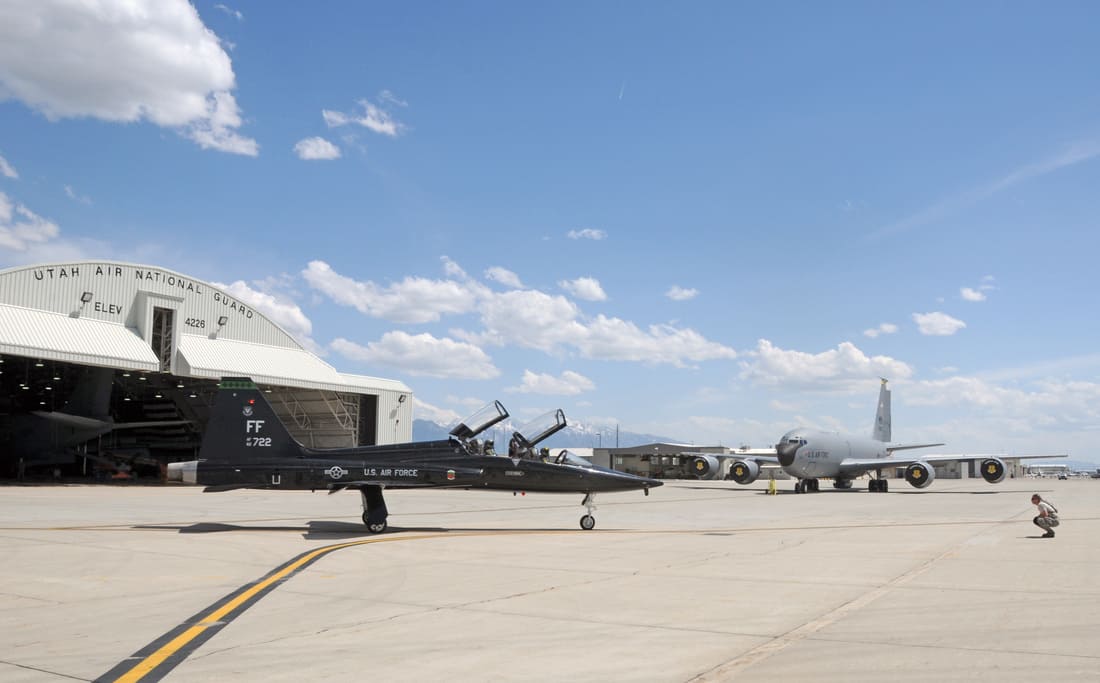Roland R. Wright Air National Guard Base in Salt Lake City will host two Air National Guard cyber operations squadrons under a Department of the Air Force stationing decision published Sept. 11. The 109th Air Control Squadron will be inactivated under the same action. Utah adds 12 full-time billets and surrenders 52 part-time authorizations during the conversion. Full operational capability is forecast for spring 2030. The move implements a fiscal 2025 directive to divest half of the Air National Guard tactical air control party and control and reporting center missions.
In Utah, the 109th Air Control Squadron, the Warlocks, is a command-and-control unit, not a TACP. Some reporting framed the national divestment in TACP terms. At Wright ANGB, the change centers on the air control mission and its manpower. The Air Force linked the inactivation to the 50 percent reduction across TACP and CRC portfolios in the Guard.
According to Utah Guard material distributed last month, the 109th will transition to cyber defense and split into the 106th and 109th Cyber Operations Squadrons, with full capability in 2031 and civil-support roles alongside federal missions. Unit numbers are finalized only through formal activation orders. State messaging lays out the intended construct and end state.
Manpower won’t map one-for-one. Air control billets cover radar, communications, and battle management. Cyber squadrons need operators, planners, and intelligence support aligned to defensive and sometimes offensive mission sets under U.S. Cyber Command tasking. Defense officials confirm the conversion will use reassignment, retraining, and targeted accessions rather than a mass separation. The Air Force statement listed only the net Utah authorization changes, not specific AFSCs.
The 109th’s public transition began last year. In July 2024, the unit’s commander, Lt. Col. Joshua McCarty, told the Guard’s official news outlet the squadron was “transitioning into two cyber units, drastically changing our equipment and personnel structure,” and added, “Cyber is the future of warfare… We need to be ready to tackle challenges not just in the air but in cyberspace as well.” The article described the 109th’s final large-scale air battle management drill before conversion.
The ANG decision follows several years of Air Force planning to reduce TACP end strength. In mid-2023, the Department projected a drop from roughly 3,700 positions to about 2,130 by 2025, a 44 percent cut phased over three fiscal years. The plan paired with a broader re-optimization of close-air support and air-ground integration for a high-threat environment, with Army-Air Force liaison structures under review.
Operational demand for cyber forces has grown in parallel. U.S. Cyber Command’s Cyber Mission Force uses defensive, offensive, and support teams from the services, including Guard elements, to conduct national-level and DoD-network missions. Guard cyber units also work with state partners on critical infrastructure defense when requested by civil authorities. ANG squadrons in Maryland and other states show defensive operations, red-team activities, and exercise participation tied to national and coalition efforts.
Air National Guard divestment of TACP and CRC missions in fiscal 2025
Congress in FY25 authorized a halving of ANG TACP capacity and CRC elements. The Air Force cast Utah’s inactivation within that nationwide restructuring, shifting Guard manpower to priorities aligned with the current defense strategy, including cyber and other information-centric missions. The service’s release put Wright ANGB on the receiving end and provided the Utah billet changes and the spring 2030 full-up date.
The 2023 TACP plan set an end-state of roughly 2,130 TACP billets, down from about 3,700, across active, Guard, and Reserve. Observers note Guard units often carry both federal and state cyber tasks, so moving authorizations from legacy air control into cyber units delivers capacity usable under Title 10 and Title 32 when approved. Utah fits that logic without promising a template for every state.
What disappears in Utah is a radar- and communications-centric control squadron, not a TACP detachment. The Air Force grouped both families under one divestment heading, which can blur distinctions for casual readers. Read the decision literally. The Warlocks’ air control lineage stops, their billets seed two cyber squadrons, and the TACP percentage cut lands at the portfolio level rather than as a specific Utah TACP shutdown.
Roland R Wright’s base selection and unit-level changes
The choice of Wright ANGB places the new mission at a mature ANG installation with command-and-control, communications, and secure-facility experience. The 151st Wing’s infrastructure and proximity to regional tech talent offer a plausible recruiting base for cyber operators and analysts who qualify for Guard service. Defense officials confirm the Air Force selected Wright ANGB as the preferred location and paired that pick with the 109th inactivation to free authorizations.
The Utah Guard has flagged the 109th’s move toward cyber since mid-2024 and prepared the workforce for retraining and equipment transition. The command highlighted the last large readiness drill in the legacy configuration, signaling a clean pivot rather than a drawn-out dual hat. McCarty’s public comments echoed a theme seen in other states that built cyber capacity over the last decade. Personnel systems and facility accreditation take time, but units tend to retain people when leadership offers a credible path into high-demand cyber roles.
Facility work will follow accreditation standards for cyber operations, with classified processing areas, mission systems connectivity, and compliant storage. According to industry sources, a typical stand-up includes secure lab spaces, training ranges tied into exercise networks, and connectivity to national mission systems. Investments scale with chosen missions, whether defensive teams, mission defense elements tied to specific weapon systems, or national mission augmentation for USCYBERCOM, so Utah’s build may differ from other states.
Utah’s published newsletter adds a concrete detail to the unit map. It shows 106th and 109th Cyber Operations Squadron designations, a sign the state intends to preserve unit heritage while aligning with ANG cyber naming conventions. The same page places full capability in 2031, a year later than the Air Force’s spring 2030 projection. Both sources point to a multi-year ramp and a two-squadron structure.
Two cyber operations squadrons’ mission profile and timeline
Guard cyber squadrons contribute to the Cyber Mission Force alongside active-duty units. Teams execute defensive and offensive tasks under U.S. Cyber Command authorities, and Guard operators often bring civilian experience in incident response, industrial control systems, and enterprise defense. The Guard also supports state requests during major cyber incidents under rules that keep law enforcement and military roles separate.
The mission set spans multiple roles defined by USCYBERCOM and the services. A typical state portfolio includes some mix of:
- Cyber protection teams and national mission team augmentation for national-level defense and support of Combatant Command requirements.
- Mission defense teams aligned to specific weapon systems or base-level critical systems.
Utah’s cyber squadrons will step into that ecosystem. The Air Force stationing notice gives a spring 2030 target for full operational capability and lists the billet changes. Utah’s newsletter sets 2031 for full capability and adds state-mission language about protecting military and critical-infrastructure networks. The one-year gap isn’t unusual during conversion. Sequence depends on facility accreditation, personnel pipelines, and acceptance events.
Training and readiness will drive the early years. Operators must qualify on CMF tools and tactics, and the squadrons will need certified leaders for mission elements. The Guard commonly uses national cyber exercises such as Cyber Shield and Locked Shields to certify teams, while sending personnel through joint schools for planners, intelligence support, and hunt operations. Other Guard units show small cadres reaching certification first, then growing to full team manning as billets fill and facilities open.
Recruiting and retention favor Utah in several ways. The state’s civilian tech market can supply experienced analysts and engineers who understand enterprise and cloud environments. Guard service offers a part-time path for those professionals if clearances and medical standards are met. Air Force messaging emphasizes cyber specialties across active and Guard components, which can broaden the prospect pool once activation orders publish.
According to industry sources, successful stand-ups blend prior-service transfers, ROTC graduates with computer science backgrounds, and lateral entries from civilian tech roles who meet commissioning or enlistment standards.
Budget documents and program governance for the conversion
The stationing choice applies the FY25 realignment. The Air Force announcement linked Utah’s inactivation to the 50 percent Guard divestment in TACP and CRC lines and documented Utah’s manpower trade, 12 full-time increases offset by 52 part-time reductions. That pattern matches Guard cyber units, which rely on stable full-time staff to maintain readiness while drawing depth from traditional Guardsmen.
Governance runs through familiar processes. The service will issue an inactivation order for the 109th ACS, activate successor squadrons, and execute a manpower change request to shift authorizations. The base will complete environmental and facility reviews for any new construction or secure-area modification. Defense officials confirm the goal of full operational capability in spring 2030, implying interim milestones for initial operational capability, team validation, and accreditation of secure workspaces. Utah’s newsletter places final capability in 2031 and notes support for state-level cybersecurity tasks.
Other ANG examples show the likely end state. Maryland’s 175th Cyberspace Operations Group operates multiple offensive and defensive squadrons and routinely deploys teams to national and NATO exercises. ANG fact sheets describe cyber protection teams that defend DoD information networks and mission defense teams focused on specific platforms. These references sketch where Utah’s two squadrons will fit once the conversion is complete.
The Utah action translates a national directive into state force structure, with clear numbers, identified lineage for the new units, and a published window for full capability. The only difference across public documents is the final date, spring 2030 in the Air Force release and 2031 in the state newsletter.
REFERENCE SOURCES
- https://www.cybercom.mil/Media/News/Article/3206393/cyber-101-cyber-mission-force/
- https://www.af.mil/News/Article-Display/Article/4300578/wright-angb-to-gain-ang-cyber-operations-squadrons/
- https://www.defensenews.com/air/2025/09/12/utah-air-guard-base-to-wind-down-tactical-air-control-party-squadron/
- https://defensescoop.com/2025/09/15/air-national-guard-cyber-operations-squadrons-utah-roland-wright-base/
- https://www.meritalk.com/articles/utah-air-guard-base-to-add-2-new-cyber-squadrons/
- https://guard.utah.gov/wp-content/uploads/TAG-Newsletter-09-2025.pdf
- https://www.ang.af.mil/Media/Article-Display/Article/3829058/utah-air-national-guard-transitions-to-cyber-warfare-with-the-109th-air-control/
- https://www.military.com/daily-news/2023/06/21/10s-out-air-force-close-air-support-jobs-face-steep-cuts-too.html



